
- Subject:
- Applied Science
- Biology
- Life Science
- Material Type:
- Module
- Date Added:
- 07/10/2017

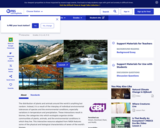
This interactive resource adapted from NASA describes the different temperature, precipitation, and vegetation patterns in seven biomes: coniferous forest, temperate deciduous forest, desert, grassland, rainforest, shrubland, and tundra.

This article continues an examination of each of the seven essential principles of the climate sciences on which the online magazine Beyond Weather and the Water Cycle is structured. Principle 3 states that life on Earth depends on, is shaped by, and affects climate. The climate dictates where and how species can survive. The author discusses the scientific concepts underlying the life forms' dependence on the climate and expands the discussion with diagrams, photos, and online resources.

A new instructional model, called Argument-Driven Inquiry (ADI), is introduced to elementary teachers in this article. The author shows how school librarians and classroom teachers can collaborate to help students construct and communicate evidence, or arguments. Evidence buckets, a collaborative activity, and related online resources are presented. The article appears in the free online magazine Beyond Weather and the Water Cycle, which is structured around the seven essential principles of climate literacy.
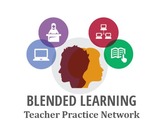
This problem-based learning module is designed to master the Ohio Learning standard of Science in Earth and Space Science number 2, Cycles and Patterns of Earth and the Moon. Thermal-energy transfers in the ocean and the atmosphere contribute to the formation of currents, which influence global climate patterns. Students will be exploring the various factors affecting the climate patterns we experience due to thermal energy. Students will work independently as well as with a partner. The final product is expected to be presented to their peers and teachers. This blended module includes teacher-led instruction, student-led stations, real world data analysis and technology integrated investigations.
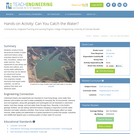
Students construct three-dimensional models of water catchment basins using everyday objects to form hills, mountains, valleys and water sources. They experiment to see where rain travels and collects, and survey water pathways to see how they can be altered by natural and human activities. Students discuss how engineers design structures that impact water collection, as well as systems that clean and distribute water.

In this nonfiction story, young readers and listeners learn how scientists use cross sections from trees to reconstruct past climates. Versions are provided for readers at two levels, k-2 and 3-5, and in text-only and illustrated formats. The story is also available as an electronic book with recorded narration. An original story is a regular feature of each issue of the free, online magazine Beyond Weather and the Water Cycle. The story can be used in science and literacy lessons and activities throughout the magazine.
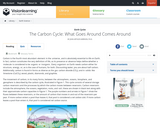
This module provides an overview of the biogeochemical carbon cycle. Major sources and sinks of carbon are discussed as well as the impact of human activities on global carbon levels.
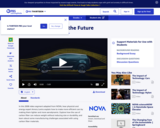
In this video segment adapted from NOVA, find out how cars made of a material stronger than steel and half the weight can help combat climate change.
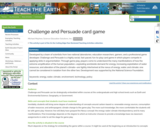
Developed by a team of scientists from two national laboratories, education researchers, gamers, and a professional game developer, Challenge and Persuade is a highly social, fast-paced, fun-to-play card game in which players compete in applying skills in argumentation. Through game play, players come to understand the many manifestations of how the extreme amplification of the human population, exploding worldwide demand for energy, increasing exploitation of water resources, and alteration of the planet's climateâare tightly intertwined at the nexus of energy, water, and climate; one cannot be considered in isolation from the other two. Development was supported by the National Science Foundation.
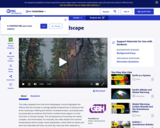
In this video adapted from the Arctic Athabaskan Council, learn how warmer temperatures in the Arctic are transforming the landscape, triggering a host of effects such as permafrost thawing and insect infestations.
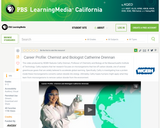
In this video produced for Teachers' Domain, learn about MIT professor Cathy Drennan's research into microorganisms that remove carbon dioxide, a greenhouse gas, from the atmosphere.

This article continues an examination of each of the seven essential principles of climate literacy on which the online magazine Beyond Weather and the Water Cycle is structured. Principle 2 covers the complex interactions among the components of the Earth system. The author discusses the scientific concepts underlying the interactions and expands the discussion with diagrams, photos, and online resources.
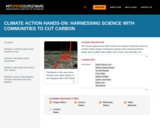
This course explores how citizen science can support community actions to combat climate change. Participants will learn about framing problems, design ways to gather data, gather some of their own field data, and consider how the results can enable action. Leaks in the natural gas system—a major source of methane emissions, and a powerful contributor to climate change—will be a particular focus. The course was organized by ClimateX and Fossil Free MIT, with support from the National Science Foundation for the methane monitoring equipment. It was offered during the Independent Activities Period (IAP), which is a special 4-week January term at MIT.

This course explores how citizen science can support community actions to combat climate change. Participants will learn about framing problems, design ways to gather data, gather some of their own field data, and consider how the results can enable action. Leaks in the natural gas system—a major source of methane emissions, and a powerful contributor to climate change—will be a particular focus.
The course was organized by ClimateX and Fossil Free MIT, with support from the National Science Foundation for the methane monitoring equipment. It was offered during the Independent Activities Period (IAP), which is a special 4-week January term at MIT.

This course has been designed to help professionals working across multiple disciplines bring a climate change adaptation lens to their current and future projects.
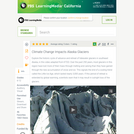
This video adapted from KTOO takes a look at Earth's warming and cooling cycles and the current atypical trend of warming that is impacting the glaciers in Alaska's Inside Passage.

This article features children's literature about weather, climate, and climate change. What’s the difference between weather and climate? How do scientists observe, measure, and predict weather phenomena? How is Earth’s climate changing, and why? This month’s bookshelf will help students develop a solid grasp of weather-related concepts. It will also introduce students to global warming and climate change and inspire them to do what they can to combat the problem.
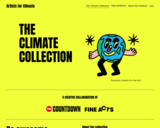
A collaboration between TED Countdown and Fine Acts, Artists for Climate started as a global open call that sought digital illustrations targeting climate change, with a focus on hope and solutions.
The artworks you see here have been published online under a Creative Commons license and are available for anyone to use and adapt non-commercially, to help shift the global narrative of the climate crisis towards a brighter future. This hopeful collection is an invaluable resource and tool for educators and organizations from around the world, working towards climate action.
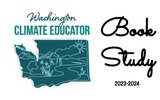
This resource shares all of the documents and planning guidance for the Washington Climate Educator Book Club, which is part of the greater ClimeTime community. The Book Club’s book study is designed to flexibly support teams of interdisciplinary K–12 educators, from schools and districts across Washington, to explore ways climate education can be integrated into all classrooms.